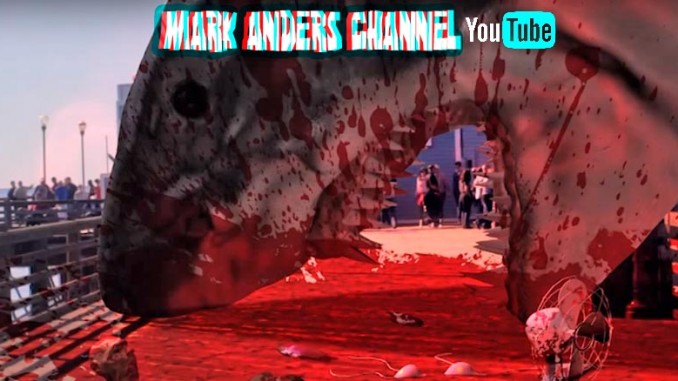
Giant 60 foot Tall Shark on Oceanside Pier in Oceanside, California
In their contemplative discourse, both Harry Callahan and Paul Kersey engage in a profound dialogue that delves into the intricate web of concerns faced by sculptors as they embark on the challenging journey of placing their artistic creations in public spaces. Amidst these multifaceted considerations, a paramount theme emerges—financial viability. The vexing question of funding looms large on the horizon, entailing intricate negotiations between the realms of public and private financial backing. In this intricate ballet of resources, sculptors must tread carefully, for it is the lifeblood that nurtures their artistic vision and brings their dreams to tangible reality.
Yet, financial concerns merely scratch the surface of the sculptor’s odyssey. Zoning issues, a labyrinth of red tape and regulatory hurdles, pose a formidable challenge. Negotiating the intricate terrain of municipal zoning regulations and compliance becomes a delicate dance of bureaucracy. Here, the sculptor must don the mantle of diplomat, navigating the treacherous waters of local governance, and forging a path towards manifesting their creative vision within the confines of the law.
An additional layer of complexity emerges in the form of opposing interest groups. These formidable adversaries may vehemently oppose the very existence of the sculpture, their objections rooted in diverse perspectives. The potential for offense to certain groups, the specter of political incorrectness, and the shadow of sexism all cast long, scrutinizing gazes upon the artist’s creation. As artists, they find themselves ensnared within the web of social consciousness, grappling with the need to strike a harmonious balance between artistic expression and the imperative of adhering to prevailing norms and sensitivities.
Media amplification serves as a double-edged sword. While it possesses the power to bestow fame and recognition, even a single unfavorable article has the potential to reverberate as a discordant note that may threaten the entire artistic endeavor. The media’s mercurial favor can either propel the sculpture into the limelight or consign it to obscurity.
The role of politicians in this intricate tapestry is equally pivotal. The artist must discern the stance of those in positions of power, understanding how their political sway may influence the destiny of the sculpture. Favorable sentiments from influential figures can breathe life into the project, while opposition could sound its death knell.
Sculptors must also don the hat of an engineer, delving into the structural intricacies of their creation. The daunting task of ensuring the sculpture’s stability and resistance to collapse falls squarely upon their shoulders. It is a realm where the aesthetic vision converges with the laws of physics, demanding meticulous craftsmanship to ensure the creation withstands the test of time.
In this intricate ballet of artistry, regulation, politics, and engineering, the sculptor embarks on a profound journey. With every step, they must harmonize the myriad complexities that underscore their creative vision, striving to find equilibrium within the tumultuous landscape of public art installation.
A monumental ambition stirred the artistic realm in the form of a colossal 50-foot sculpture honoring the illustrious Greek god Neptune, aptly christened as the “Spirit of the Seas.” The sculptor’s vision was an ambitious endeavor slated for completion and installation along the picturesque shores of the San Diego Bay, with the target year set for 2007. The vision, however, remained unrealized, lost in the labyrinthine corridors of public sentiment.
The conceptual sculpture was to serve as an embodiment of Neptune, a majestic figure embodying the formidable spirit of the sea. But controversy brewed on various fronts, casting shadows of doubt over its intended creation. Among the most vociferous objections were the voices of women’s groups, who fervently objected to the sculpture’s distinctively male representation. The clash of artistic intention and gender-sensitive perspectives collided, opening a chasm of debate that echoed in the realms of artistic freedom and social representation.
In tandem with these gender-based reservations, an alternative perspective emerged from those advocating for a more abstract and less representational manifestation of the sculpture. A spirited debate ensued, with proponents of abstraction contending that it would transcend the boundaries of gender and foster a broader, universal appreciation.
Critics of the grand endeavor, including esteemed San Diego Union Tribune writer Robert L. Pincus, took an unwavering stance against the project. In his scathing critique, Pincus raised concerns that resonated with many, pushing back against the tangible representation of Neptune and challenging the envisioned artistic concept.
Thus, within this maelstrom of conflicting viewpoints, the colossal “Spirit of the Seas” sculpture found itself ensnared in a web of controversy and contention, casting doubt upon its eventual manifestation and the profound question of artistic expression versus societal sensibilities.
“Spirit of the Seas” would be a towering monument to nothing more than artistic timidity and ambitious entrepreneurship. It has precious little to say about San Diego, while it would tell the world this is one excruciatingly parochial town when it comes to art or monuments.
If this is the future for art in public places here, then let’s have public places without art. I’d rather look at an unfettered view of the bay than see a 50-foot bronze Neptune done in some vaguely retro-mannerist style rise before our eyes.
-Robert L. Pincus, San Diego Union Tribune
Our report on the 60 foot Megalodon Shark roughly parallels some of the trials and tribulations of San Diego’s ill fated “Spirit of the Seas”.
The video:
Biggest Megalodon Shark Transcript, Mark Anders Channel
BEGIN TRANSCRIPT

Harry Callahan: What is Oceanside known for? What kid of landmark? See, I don’t like this idea of what they’re going to turn into a landmark in San Diego, a giant shark munching on people.
Paul Kersey: That’s just the problem. Oceanside doesn’t have a landmark. They’ve got a military base.
Harry Callahan: They have that little house that was used in Top Gun.
Paul Kersey: They do have that. That is a landmark. That was from a huge movie. Top Gun. You’re right but they want to put in something else. They want to create an awareness. They want to bring a shark to the Oceanside Pier.
Harry Callahan: First of all, what’s the expense of having a 70 foot tall shark that blocks the pier?
Paul Kersey: It doesn’t block the pier. Its almost like having the statue of liberty. This is really going to do wonders for the city. It’s magic!
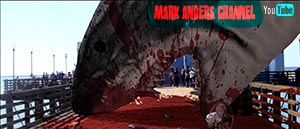
Harry Callahan: They have a twenty foot wide, or whatever, pier where people can freely walk by. Now, they’re trying to propose a 50 foot shark that’s mouth is blocking practically 90% of the 20 foot pier.
Paul Kersey: You made a perfect point. Its blocking 90% of the pier. Its a bottle neck. You can’t ignore it. You’re now aware of a shark and you had to read to plaque that’s there telling you that this is a Megalodon shark and that sharks are going extinct.
Harry Callahan: Sharks are not going extinct and this is a shark that already is extinct. Why do people have to be aware of it? Why do we have to block people’s traffic?
Paul Kersey: They want people to be aware of the ocean and how we’re destroying them.
Harry Callahan: That’s not what its about. There’s a cryptozoologist named Max Outt, who’s also a personal trainer in Southern California, and he wants to make people aware of Cryptozoology and the Megalodon. So what? We’re aware of it. We don’t need this guy blocking off piers.
Paul Kersey: Are you saying that this guy, Max Outt, has brought this to the city of Oceanside?
Harry Callahan: He’s pushing it to go through.
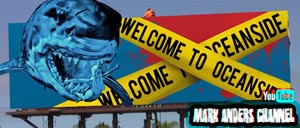
Paul Kersey: I see nothing wrong with that.
Harry Callahan: What about the massive expense to Oceanside?
Paul Kersey: There’s money that local city governments have and have to spend it on art and this is an artistic endeavor.
Harry Callahan: Maybe they should spend it on education and the poor.
Paul Kersey: That’s a perfect point. Helping the education of the young and poor. That’s what this does. This drives home education. An artistic endeavor like this is educating people on how the oceans are being destroyed.
Harry Callahan: That’s not what its about. All it is is educating people about a 60 foot shark that used to exist. The can watch something on the SyFy channel about Megalodon and they’ll know that it existed. They don’t need to spend a million dollars on a fake shark.
Paul Kersey: Can you imagine what the investment of one millions dollars will return on this? It’s huge!
Harry Callahan: What return?
Paul Kersey: The tax revenues that will come in. People will be coming from all over the world to see this beautiful example of a fantastic blood-thirsty shark.

Harry Callahan: But they already know what one is.
Paul Kersey: The impact. This has impact.
Harry Callahan: Possibly, if that creates more tourism, but the only thing is is that shark is blocking a long pier that dead ends at a restaurant at the end of a pier. The only one that would benefit from it is that restaurant.
Paul Kersey: I think it slows the flow of traffic so they can become more aware of the shark.
Harry Callahan: Okay, something we didn’t talk about, what about all the goriness. Young people can’t even get in to R rated movies but we’re have a shark with someone’s severed bloody head, bloodied shark mouth, bikini top, a bunch of dead fish coming out of it’s mouth because the sharks upside down draining carnage on to the pier?
Paul Kersey: It’s simply human nature.
Harry Callahan: What’s human nature?
Paul Kersey: Blood and gore. Why shield the young from it?
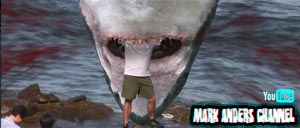
Harry Callahan: So, in other words, R rated movies should be allowed for everyone.
Paul Kersey: That’s a different thing.
Harry Callahan: Okay, well, that’s hypocrisy.
Paul Kersey: It’s certainly not. This is a wonderful artistic example here.
Harry Callahan: No. You’re exposing young people to carnage and gore. We would be losing millions of dollars in city revenue.
Paul Kersey: It’s simply an investment. It’s a city investing.
Harry Callahan: In gore?
Paul Kersey: If I had kids I would take them to this.
END TRANSCRIPT
Mark Anders Channel
Jurassic Gorilla, Gorilla Harry T-Shirt https://jurassicgorilla.com


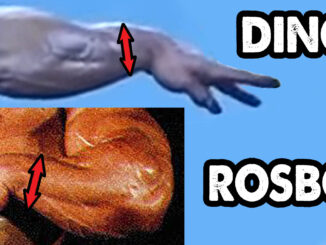


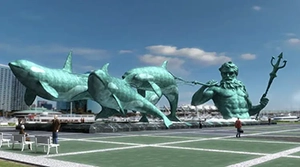
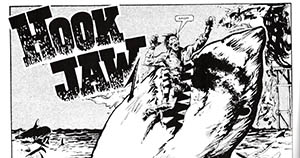


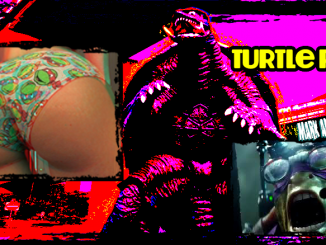
Be the first to comment